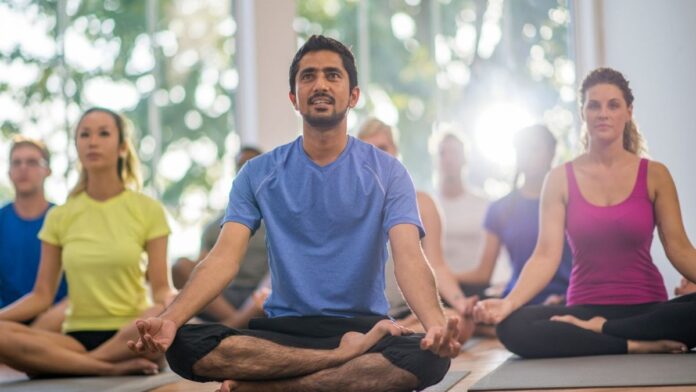Last Updated:
Through postures, breath control and relaxation, Yoga helps steady the heart and reduce hypertension naturally
For those with hypertension, Yoga therapy typically begins early in the morning. (Image: Canva)
43-year-old Rohan* had managed to bring his persistent high blood pressure of 160/120 mm Hg under control with twice-daily medication, stabilising around 130/90. Yet, despite a controlled diet, he was obese and had high cholesterol.
Within two weeks of Yoga therapy, his blood pressure came down to 120/76, allowing doctors to taper off his medication. His cholesterol reduced from 208 to 126 mg/dl.
He shared something interesting during his yogic counselling: he could handle tension well, and the ups and downs of business hardly affected him. But he had great difficulty coping with personal relationships — with his wife, children, and parents. His meticulous nature often led to conflicts, as he was easily irritated.
At the therapy centre, exposure to ideas from the Upanishads, taught as part of Jnana Yoga, brought about a complete change in his outlook. Earlier, he was certain that his way of looking at any situation was the most logical and correct; now, he began to see others’ viewpoints.
It dawned on him that harmony, not intellectual and logical superiority, was more important. He recognised that the root of his tension lay in his lack of acceptance and his high expectations of others.
As he realised that his wife’s views were valid from her perspective and deserved respect, he suddenly felt a sense of ease. This shift, along with the experience of deep relaxation and rest, helped him to come off his medication.
Stressed, Overworked, Hypertensive
High blood pressure, or hypertension, is among the most widespread lifestyle disorders in the modern world. Not a disease in itself, it is a warning sign, as it increases the risk of developing serious conditions later in life, such as heart failure, heart attack, stroke, and kidney problems. Anxiety about its consequences heightens stress, creating a vicious cycle.
People with cardiac problems are often highly sensitive and reactive, explain Yoga therapy experts Dr Nagarathna Raghuram and Dr H R Nagendra of SVYASA, Bengaluru. Yoga helps them develop equanimity of mind — to be wise and stay composed, and not be swayed by anger, anxiety, depression, or excitement.
Imbalances start in the mind, likes, dislikes, and cravings, which make a person go against what is right. One category of mental illness arises from interactions with the world. These agitations cause fluctuations in the flow of prana, leading first to digestive disturbances and then to psychosomatic ailments.
How Yoga Operates
From their experience of dealing with patients over decades, Yoga gurus Dr Nagarathna Raghuram and Dr H R Nagendra reveal that for mild hypertension, non-drug approaches such as relaxation, a balanced diet, and weight management can suffice. Controlled studies have shown the beneficial effects of Savasana (Corpse Pose), Pranayama, and meditation, practised regularly for 20–30 minutes daily.
In cases of essential hypertension, where the psychosomatic issue has progressed, resulting in blockage or permanent arterial changes, merely practising daily Yoga for 30–60 minutes without a change in life approach may not be enough.
Lifestyle changes are therefore an essential part of the plan of action, and these can deliver results within a year, including changes in the degree of blockages.
The Yogic Prescription
For those with hypertension, Yoga therapy typically begins early in the morning and includes:
- Loosening practices for the neck, shoulders, hands, legs, and trunk to mobilise the body and relax muscles.
- Cleansing Kriyas such as Jalaneti, Kapalabhati, and Vaman Dhouti to tone inner organs and enhance inner awareness.
- Correct breathing patterns, where the rate and depth of breathing are used to reduce levels of emotional excitement through various Pranayamas (avoid Kapalabhati and Bhastrika).
- Poses for physical revitalisation and deep relaxation. Three examples of these are:
Gomukhasana (Cow Face Pose): Counters chest compression common in stressed individuals, improves circulation, eases strain on the heart, and relaxes the nervous system. It also releases tension from the shoulders and promotes emotional openness.
Shashankasana (Hare Pose, a kneeling forward bend): The head on the ground, arms extended, deep and steady breathing, and the act of bowing down bring great tranquillity.
Ardhakati Chakrasana (Lateral Arc Pose): The sideways bend stimulates the muscles around the chest, spine, and abdomen, improving blood flow to the heart. A flexible thoracic spine allows better chest expansion and deeper breathing, enhancing oxygen supply to the heart tissue.
Pranayama and deep relaxation (Savasana): Both help balance heart rate and blood pressure.
What Real Lifestyle Change Is
There must be a deep attitudinal change, say the Yoga gurus, because forced changes can themselves become causes of stress and suppression.
They emphasise keeping emotional stress and anxiety at bay: “Be a karma yogi,” they advise, “learn to relax, spend time with family, and do things that allow the release of bottled-up emotions.”
A lifestyle built on joy and contentment forms the core of this, and Yoga can be a great tool in the process.
Yama and Niyama (the dos and don’ts for living in society) from Patanjali’s Ashtanga Yoga, Karma Yoga (Yoga of Action), Bhakti Yoga (Yoga of Love and Devotion), and Jnana Yoga (teachings from the scriptures) are highly evolved, time-tested techniques for healthy living.
These guide us towards moderation and help control instinctive behavioural patterns. A new purpose and meaning in life emerge. Yoga ultimately leads one towards peace and stability, beyond life’s ups and downs.
The Four Yogas For Heart Health
Yoga therapy for hypertension involves integrating the four streams of Yoga into daily life:
- Karma Yoga (Yoga of Action): Performing one’s duties selflessly and to the best of one’s abilities reduces resentment.
- Bhakti Yoga (Yoga of Love and Devotion): Working for the sake of love and surrendering one’s actions and even thoughts through prayer, chanting, or gratitude releases emotional burdens and yields a deep sense of security.
- Jnana Yoga (Yoga of Knowledge): Developing the right understanding dissolves the roots of emotional reactivity.
- Ashtanga Yoga: Starting with Yama and Niyama (dos and don’ts for social living) through to Asana, Pranayama, and Dhyana (meditation), it provides peace of mind and sustained mental calmness.
Eating Heartily, Not Just Right
Excess protein, alcohol, tobacco, pollution, work pressure, and aggression all strain the heart.
For those engaged in intensive brain work, Yoga recommends sattvic food — three moderate, freshly cooked, balanced meals, mostly carbohydrates, limited protein and fats, a mix of raw and cooked vegetables, minimal spices, and adequate fluids.
Food eaten in warm, friendly company is essential for improving heart function, say the Yoga gurus.
*Names have been changed to protect privacy.
Note to readers: This article is meant for informational purposes only. Consult your healthcare professional before starting any exercise regimen. Always learn Yoga at an established centre, from experienced teachers, and under medical supervision.
The author is a journalist, cancer survivor and certified yoga teacher. She can be reached at swatikamal@gmail.com.
November 08, 2025, 11:21 IST

